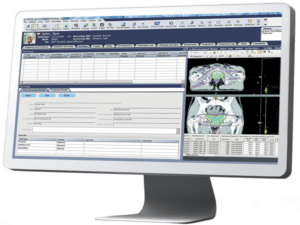Radiation therapy technology is advancing rapidly, with new linear accelerators (linacs) entering the market while…

Record & Verify Software for your Linear Accelerator
Linear accelerators have become increasingly more sophisticated over the last two decades. The advent of IMRT (intensity modulated radiation therapy), as well as CBCT (cone beam CT) and VMAT (volumetric arc therapy) means that more data is generated from the linear accelerator than ever before.
In order to keep all of the patient data organized, a Record and Verify System (R&V) should be used. An R&V system is simply a computer server and related software that organizes and stores all of the data that is fed into, or captured from, the linear accelerator and the related patient being treated.
An R&V system is different, and not to be confused, with a Treatment Planning System (TPS). The TPS, also a computer, is used to calculate the “treatment plan,” which is essentially the optimal way for the linear accelerator (or other device) to deliver a specific dose of radiation to the patient. The TPS provides the guidance to the linear accelerator as to which beam angles to use, how the beam should be shaped at each angle, and other such instructions. However, the TPS is not connected to the linear accelerator directly. Its “instructions” are communicated either manually, by the clinician, or automatically, via the R&V system.An R&V system therefore prevents the need for a clinician to have to manually enter instructions into the linear accelerator system, thereby eliminating the potential for human error.
The R&V system has evolved to include DICOM-RT image storage, patient scheduling information, and a whole host of other features and benefits. Today, R&V systems are more commonly referred to as “Oncology Information Systems” (OIS) or “Oncology Management Systems” (OMS).
As to which OIS systems are in use around the world, a recent survey conducted on the Global Medical Physics List Server showed the following:
For many years, IMPAC, the developer of what it today the Mosaiq system, was the world’s undisputed market leader in R&V software. However, when Elekta acquired IMPAC in 2005, Varian Medical Systems went to work on improving its own, proprietary system, which is today known as Aria. Based on this survey, today, Aria is leading the pack as the OIS software leader.
A good, economical option is the Prowess OIS system. It is a distant third to Aria and Mosaiq, but quickly gaining market share, especially among buyers of pre-owned eqipment.
RaySearch Labs is currently working on another OIS system, dubbed “RayCare,” which is scheduled for release in the near future, and promises even more advanced features and capabilities.





